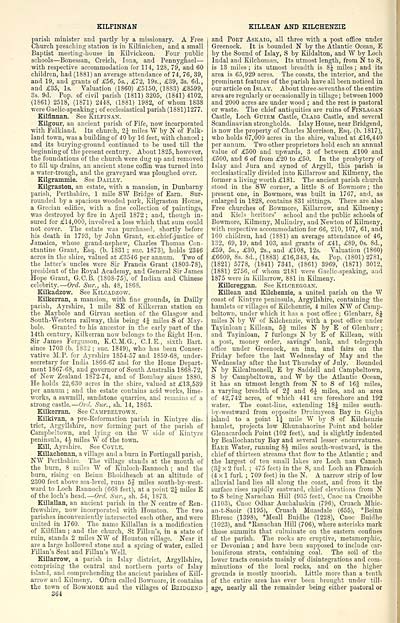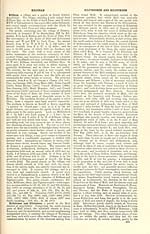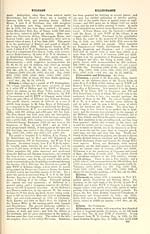Ordnance gazetteer of Scotland > Volume 4
(146) Page 364
Download files
Complete book:
Individual page:
Thumbnail gallery: Grid view | List view

KILFINNAN
KILLEAN AND KILCHENZIE
parish minister and partly by a missionary. A Free
Church preaching station is in Kilfinichen, and a small
Baptist meeting-house in Kilvickeon. Four public
schools — Bonessan, Creich, Iona, and Pennyghael —
with respective accommodation for 114, 128, 79, and 60
children, had (1881) an average attendance of 74, 76, 39,
and 19, and grants of £56, 5s., £72, 19s., £39, 3s. 6d.,
and £35, Is. Valuation (1860) £5150, (1883) £8599,
3s. 9d. Pop. of civil parish (1811) 3205, (1841) 4102,
(1861) 2518, (1871) 2448, (1881) 1982, of whom 1838
were Gaelic-speaking; of ecclesiastical parish (1881)1277.
Kilfinnan. See Kilfinan.
Kilgour, an ancient parish of Fife, now incorporated
with Falkland. Its church, 2J miles W by 1ST of Falk-
land town, was a building of 40 by 16 feet, with chancel ;
and its burying-ground continued to be used till the
beginning of the present century. About 1825, however,
the foundations of the church were dug up and removed
to fill up drains, an ancient stone coffin was turned into
a water-trough, and the graveyard was ploughed over.
Kilgrammie. See Dailly.
Kilgraston, an estate, with a mansion, in Dunbarny
parish, Perthshire, 1 mile SW Bridge of Earn. Sur-
rounded by a spacious wooded park, Kilgraston House,
a Grecian edifice, with a fine collection of paintings,
was destroyed by fire in April 1872 ; and, though in-
sured for £14,000, involved a loss which that sum could
not cover. The estate was purchased, shortly before
his death in 1793, by John Grant, ex-chief-justice of
Jamaica, whose grand-nephew, Charles Thomas Con-
stautine Grant, Esq. (b. 1831 ; sue. 1873), holds 2346
acres in the shire, valued at £3546 per annum. Two of
the latter's uncles were Sir Francis Grant (1803-78),
president of the Royal Academy, and General Sir James
Hope Grant, G.C.B. (1808-75), of Indian and Chinese
celebrity.— Ord. Eur., sh. 48, 1S6S.
Kilkadzow. See Kilcadzow.
Kilkerran, a mansion, with fine grounds, in Dailly
parish, Ayrshire, 1 mile SE of Kilkerran station on
the Maybole and Girvan section of the Glasgow and
South-Western railway, this being 4J miles S of May-
bole. Granted to his ancestor in the early part of the
14th century, Kilkerran now belongs to the Right Hon.
Sir James Fergusson, K.C.M.G., CLE., sixth Bart,
since 1703 (b. 1832 ; sue. 1849), who has been Conser-
vative M.P. for Ayrshire 1854-57 and 1859-6S, under-
secretary for India 1866-67 and for the Home Depart-
ment 1867-68, and governor of South Australia 186S-72,
of New Zealand 1S72-74, and of Bombay since 1880.
He holds 22,630 acres in the shire, valued at £13,539
per annum ; and the estate contains acid works, lime-
works, a sawmill, sandstone quarries, and remains of a
strong castle. — Ord. Sur., sh. 14, 1S63.
Kilkerran. See Campbeltown.
Kilkivan, a pre-Reformation parish in Kiutyre dis-
trict, Argyllshire, now forming part of the parish of
Campbeltown, and lying on the W side of Kintyre
peninsula, 4 J miles W of the town.
Kill, Ayrshire. See Cotle.
Killachonan, a village and a burn in Fortingall parish,
NW Perthshire. The village stands at the mouth of
the burn, 8 miles W of Kinloch-Rannoch ; and the
burn, rising on Beinn Bhoidheach at an altitude of
2300 feet above sea-level, runs 5g miles south-by-west-
ward to Loch Rannoch (668 feet), at a point 2J miles E
of the loch's head. — Ord. Sur., sh. 54, 1873.
Killallan, an ancient parish in the N centre of Ren-
frewshire, now incorporated with Houston. The two
parishes inconveniently intersected each other, and were
united in 1760. The name Killallan is a modification
of Kilfillan ; and the church, St Fillan's, in a state of
ruin, stands 2 miles NW of Houston village. Near it
are a large hollowed stone and a spring of water, called
Fillan's Seat and Fillan's Well.
Killarrow, a parish in Islay district, Argyllshire,
comprising the central and northern parts of Islay
island, and comprehending the ancient parishes of Kill-
arrow and Kilmeny. Often called Bowmore, it contains
the town of Bowmore and the villages of Bridgend
364
and Poet Askaig, all three with a post office under
Greenock. It is bounded N by the Atlantic Ocean, E
by the Sound of Islay, S by Kildalton, and W by Loch
Indal and Kilchoman. Its utmost length, from N to S,
is 13 miles ; its utmost breadth is 8J miles ; and its
area is 65,929 acres. The coasts, the interior, and the
prominent features of the parish have all been noticed in
our article on Islay. About three-sevenths of the entire
area are regularly or occasionally in tillage ; between 1000
and 2000 acres are under wood ; and the rest is pastoral
or waste. The chief antiquities are ruins of Finlagan
Castle. Loch Guiem Castle, Claig Castle, and several
Scandinavian strongholds. Islay House, near Bridgend,
is now the property of Charles Morrison, Esq. (b. 1817),
who holds 67,000 acres in the shire, valued at £16,440
per annum. Two other proprietors hold each an annual
value of £500 and upwards, 3 of between £100 and
£500, and 6 of from £20 to £50. In the presbytery of
Islay and Jura and synod of Argyll, this parish is
ecclesiastically divided into Killarrow and Kilmeny, the
former a living worth £181. The ancient parish church
stood in the SW corner, a little S of Bowmore ; the
present one, in Bowmore, was built in 1767, and, as
enlarged in 1828, contains 831 sittings. There are also
Free churches of Bowmore, Killarrow, and Kilmeny ;
and Kiels heritors' school and the public schools of
Bowmore, Kilmeny, Mulindry, and Newton of Kilmeny,
with respective accommodation for 66, 210, 107, 61, and
160 children, had (1881) an average attendance of 46,
132, 69, 19, and 103, and grants of £41, £89, 0s. 8d.,
£59, 5s., £30, 2s., and £108, 12s. Valuation (I860)
£6609, 8s. 8d., (1883) £16,343, 4s. Pop. (1801) 2781,
(1821) 5778, (1841) 7341, (1861) 3969, (1871) 3012,
(1881) 2756, of whom 2181 were Gaelic-speaking, and
1875 were in Killarrow, 881 in Kilmeny.
Killcreggan. See Kilceeggan.
Killean and Kilchenzie, a united parish on the W
coast of Kintyre peninsula, Argyllshire, containing the
hamlets or villages of Kilchenzie, 4 miles NW of Camp-
beltown, under which it has a post office ; Glenbarr, SJ
miles N by W of Kilchenzie, with a post office under
Tayinloan ; Killean, 5f miles N by E of Glenbarr ;
and Tayinloan, 7 furlongs N by E of Killean, with
a post, money order, savings' bank, and telegraph
office under Greenock, an inn, and fairs on the
Friday before the last Wednesday of May and the
Wednesday after the last Thursday of July. Bounded
N by Kilcalmonell, E by Saddell and Campbeltown,
S by Campbeltown, and W by the Atlantic Ocean,
it has an utmost length from N to S of 16g miles,
a varying breadth of 2| and 6| miles, and an area
of 42,742 acres, of which 441 are foreshore and 192
water. The coast-line, extending 18J miles south-
by-westward from opposite Druimyeon Bay in Gigha
island to a point 1^ mile W by S of Kilchenzie
hamlet, projects low Rhunahaorine Point and bolder
Glenacardoch Point (102 feet), and is slightly indented
by Beallochantuy Bay and several lesser encurvatures.
Baee Water, running 8^ miles south-westward, is the
chief of thirteen streams that flow to the Atlantic ; and
the largest of ten small lakes are Loch nan Canach
(3| x 2 furl. ; 475 feet) in the S, and Loch an Fhraoich
(4x1 furl. ; 709 feet) in the N. A narrow strip of low
alluvial land lies all along the coast, and from it the
surface rises rapidly eastward, chief elevations from N
to S being Narachan Hill (935 feet), Cnoc na Craoibhe
(1103), Cnoc Odhar Auchaluskin (796), Cruach Mhic-
an-t-Saoir (1195), Cruach Muasdale (655), *Beinn
Bhreac (1398), *Meall Buidhe (1228), Cnoc Buidhe
(1023), and *Ranachan Hill (706), where asterisks mark
those summits that culminate on the eastern confines
of the parish. The rocks are eruptive, metamorphic,
or Devonian ; and have been supposed to include car-
boniferous strata, containing coal. The soil of the
lower tracts consists mainly of disintegrations and com-
minutions of the local rocks, and on the higher
grounds is mostly moorish. Little more than a tenth
of the entire area has ever been brought under till-
age, nearly all the remainder being either pastoral or
KILLEAN AND KILCHENZIE
parish minister and partly by a missionary. A Free
Church preaching station is in Kilfinichen, and a small
Baptist meeting-house in Kilvickeon. Four public
schools — Bonessan, Creich, Iona, and Pennyghael —
with respective accommodation for 114, 128, 79, and 60
children, had (1881) an average attendance of 74, 76, 39,
and 19, and grants of £56, 5s., £72, 19s., £39, 3s. 6d.,
and £35, Is. Valuation (1860) £5150, (1883) £8599,
3s. 9d. Pop. of civil parish (1811) 3205, (1841) 4102,
(1861) 2518, (1871) 2448, (1881) 1982, of whom 1838
were Gaelic-speaking; of ecclesiastical parish (1881)1277.
Kilfinnan. See Kilfinan.
Kilgour, an ancient parish of Fife, now incorporated
with Falkland. Its church, 2J miles W by 1ST of Falk-
land town, was a building of 40 by 16 feet, with chancel ;
and its burying-ground continued to be used till the
beginning of the present century. About 1825, however,
the foundations of the church were dug up and removed
to fill up drains, an ancient stone coffin was turned into
a water-trough, and the graveyard was ploughed over.
Kilgrammie. See Dailly.
Kilgraston, an estate, with a mansion, in Dunbarny
parish, Perthshire, 1 mile SW Bridge of Earn. Sur-
rounded by a spacious wooded park, Kilgraston House,
a Grecian edifice, with a fine collection of paintings,
was destroyed by fire in April 1872 ; and, though in-
sured for £14,000, involved a loss which that sum could
not cover. The estate was purchased, shortly before
his death in 1793, by John Grant, ex-chief-justice of
Jamaica, whose grand-nephew, Charles Thomas Con-
stautine Grant, Esq. (b. 1831 ; sue. 1873), holds 2346
acres in the shire, valued at £3546 per annum. Two of
the latter's uncles were Sir Francis Grant (1803-78),
president of the Royal Academy, and General Sir James
Hope Grant, G.C.B. (1808-75), of Indian and Chinese
celebrity.— Ord. Eur., sh. 48, 1S6S.
Kilkadzow. See Kilcadzow.
Kilkerran, a mansion, with fine grounds, in Dailly
parish, Ayrshire, 1 mile SE of Kilkerran station on
the Maybole and Girvan section of the Glasgow and
South-Western railway, this being 4J miles S of May-
bole. Granted to his ancestor in the early part of the
14th century, Kilkerran now belongs to the Right Hon.
Sir James Fergusson, K.C.M.G., CLE., sixth Bart,
since 1703 (b. 1832 ; sue. 1849), who has been Conser-
vative M.P. for Ayrshire 1854-57 and 1859-6S, under-
secretary for India 1866-67 and for the Home Depart-
ment 1867-68, and governor of South Australia 186S-72,
of New Zealand 1S72-74, and of Bombay since 1880.
He holds 22,630 acres in the shire, valued at £13,539
per annum ; and the estate contains acid works, lime-
works, a sawmill, sandstone quarries, and remains of a
strong castle. — Ord. Sur., sh. 14, 1S63.
Kilkerran. See Campbeltown.
Kilkivan, a pre-Reformation parish in Kiutyre dis-
trict, Argyllshire, now forming part of the parish of
Campbeltown, and lying on the W side of Kintyre
peninsula, 4 J miles W of the town.
Kill, Ayrshire. See Cotle.
Killachonan, a village and a burn in Fortingall parish,
NW Perthshire. The village stands at the mouth of
the burn, 8 miles W of Kinloch-Rannoch ; and the
burn, rising on Beinn Bhoidheach at an altitude of
2300 feet above sea-level, runs 5g miles south-by-west-
ward to Loch Rannoch (668 feet), at a point 2J miles E
of the loch's head. — Ord. Sur., sh. 54, 1873.
Killallan, an ancient parish in the N centre of Ren-
frewshire, now incorporated with Houston. The two
parishes inconveniently intersected each other, and were
united in 1760. The name Killallan is a modification
of Kilfillan ; and the church, St Fillan's, in a state of
ruin, stands 2 miles NW of Houston village. Near it
are a large hollowed stone and a spring of water, called
Fillan's Seat and Fillan's Well.
Killarrow, a parish in Islay district, Argyllshire,
comprising the central and northern parts of Islay
island, and comprehending the ancient parishes of Kill-
arrow and Kilmeny. Often called Bowmore, it contains
the town of Bowmore and the villages of Bridgend
364
and Poet Askaig, all three with a post office under
Greenock. It is bounded N by the Atlantic Ocean, E
by the Sound of Islay, S by Kildalton, and W by Loch
Indal and Kilchoman. Its utmost length, from N to S,
is 13 miles ; its utmost breadth is 8J miles ; and its
area is 65,929 acres. The coasts, the interior, and the
prominent features of the parish have all been noticed in
our article on Islay. About three-sevenths of the entire
area are regularly or occasionally in tillage ; between 1000
and 2000 acres are under wood ; and the rest is pastoral
or waste. The chief antiquities are ruins of Finlagan
Castle. Loch Guiem Castle, Claig Castle, and several
Scandinavian strongholds. Islay House, near Bridgend,
is now the property of Charles Morrison, Esq. (b. 1817),
who holds 67,000 acres in the shire, valued at £16,440
per annum. Two other proprietors hold each an annual
value of £500 and upwards, 3 of between £100 and
£500, and 6 of from £20 to £50. In the presbytery of
Islay and Jura and synod of Argyll, this parish is
ecclesiastically divided into Killarrow and Kilmeny, the
former a living worth £181. The ancient parish church
stood in the SW corner, a little S of Bowmore ; the
present one, in Bowmore, was built in 1767, and, as
enlarged in 1828, contains 831 sittings. There are also
Free churches of Bowmore, Killarrow, and Kilmeny ;
and Kiels heritors' school and the public schools of
Bowmore, Kilmeny, Mulindry, and Newton of Kilmeny,
with respective accommodation for 66, 210, 107, 61, and
160 children, had (1881) an average attendance of 46,
132, 69, 19, and 103, and grants of £41, £89, 0s. 8d.,
£59, 5s., £30, 2s., and £108, 12s. Valuation (I860)
£6609, 8s. 8d., (1883) £16,343, 4s. Pop. (1801) 2781,
(1821) 5778, (1841) 7341, (1861) 3969, (1871) 3012,
(1881) 2756, of whom 2181 were Gaelic-speaking, and
1875 were in Killarrow, 881 in Kilmeny.
Killcreggan. See Kilceeggan.
Killean and Kilchenzie, a united parish on the W
coast of Kintyre peninsula, Argyllshire, containing the
hamlets or villages of Kilchenzie, 4 miles NW of Camp-
beltown, under which it has a post office ; Glenbarr, SJ
miles N by W of Kilchenzie, with a post office under
Tayinloan ; Killean, 5f miles N by E of Glenbarr ;
and Tayinloan, 7 furlongs N by E of Killean, with
a post, money order, savings' bank, and telegraph
office under Greenock, an inn, and fairs on the
Friday before the last Wednesday of May and the
Wednesday after the last Thursday of July. Bounded
N by Kilcalmonell, E by Saddell and Campbeltown,
S by Campbeltown, and W by the Atlantic Ocean,
it has an utmost length from N to S of 16g miles,
a varying breadth of 2| and 6| miles, and an area
of 42,742 acres, of which 441 are foreshore and 192
water. The coast-line, extending 18J miles south-
by-westward from opposite Druimyeon Bay in Gigha
island to a point 1^ mile W by S of Kilchenzie
hamlet, projects low Rhunahaorine Point and bolder
Glenacardoch Point (102 feet), and is slightly indented
by Beallochantuy Bay and several lesser encurvatures.
Baee Water, running 8^ miles south-westward, is the
chief of thirteen streams that flow to the Atlantic ; and
the largest of ten small lakes are Loch nan Canach
(3| x 2 furl. ; 475 feet) in the S, and Loch an Fhraoich
(4x1 furl. ; 709 feet) in the N. A narrow strip of low
alluvial land lies all along the coast, and from it the
surface rises rapidly eastward, chief elevations from N
to S being Narachan Hill (935 feet), Cnoc na Craoibhe
(1103), Cnoc Odhar Auchaluskin (796), Cruach Mhic-
an-t-Saoir (1195), Cruach Muasdale (655), *Beinn
Bhreac (1398), *Meall Buidhe (1228), Cnoc Buidhe
(1023), and *Ranachan Hill (706), where asterisks mark
those summits that culminate on the eastern confines
of the parish. The rocks are eruptive, metamorphic,
or Devonian ; and have been supposed to include car-
boniferous strata, containing coal. The soil of the
lower tracts consists mainly of disintegrations and com-
minutions of the local rocks, and on the higher
grounds is mostly moorish. Little more than a tenth
of the entire area has ever been brought under till-
age, nearly all the remainder being either pastoral or
Set display mode to: Large image | Transcription
Images and transcriptions on this page, including medium image downloads, may be used under the Creative Commons Attribution 4.0 International Licence unless otherwise stated. ![]()
| Gazetteers of Scotland, 1803-1901 > Ordnance gazetteer of Scotland > Volume 4 > (146) Page 364 |
|---|
| Permanent URL | https://digital.nls.uk/97382098 |
|---|
| Attribution and copyright: |
|
|---|---|

